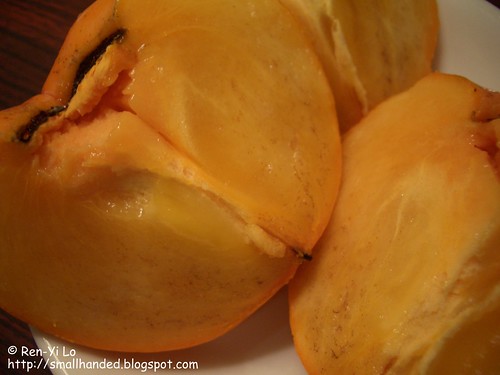Tomatoes were always regarded as vegetables in our household, so why was this a fruit? (Never mind the biologist's argument that tomatoes are fruit for now). So this "sweet vegetable" was a fruit, lacked the fluid, seedy chambers of a tomato, but had a similar skin and flesh texture.
I was re-introduced to this fruit again by a coworker in 2004. She was very generous to share these with me and I was instantly hooked on these "orange tomatoes." Her culture calls it the "Sharon Fruit" and my grandmother calls them shì zi (柿子).
There are two kinds of persimmons: astringent and non-astringent.
Astringent persimmons contain high levels of tannins, which is responsible for the dry, puckering aftertaste when consuming unripe fruit. Therefore, astringent persimmons should not be consumed until they are ripe and soft; they should feel like overripe apricots or peaches. The ripening process is what rids the high levesl of tannins. The most common persimmon is the Japanese persimmon, recognizable by its distinct heart-shape body. Trying to eat them before they are ripe gives off a chalky and displeasing aftertaste and texture in the mouth. I speak from experience ;)
Non-astrigent persimmon (my favorites!) are less fussy about when they are eaten, since they have low levels of tannis. I like them when they are still firm and waxy on the outside, since they are crispy like an apple on the outside, yet fleshy and not mush like pumpkin pulp. However, consuming them while they are over-ripe is also fine. The most common persimmon have no tip like its Japanese cousin; instead it is squat like a beef-steak tomato and often also have the label 'fuyu' when it is sold.
While perusing the grocery stalls in Hong Kong, I could not resist picking up one of these.


We enjoyed this persimmon chilled. And although my parents were hesitant about consuming this persimmon while "unripe," with some coaxing they enjoyed this new way, since the fruit tasted crisp, fresh and light, and was less messy. :)
Today persimmons can be easily found in any major grocery store during the winter months and almost year around at any Asian grocery store. If you have not tried them, you are in for a treat. Let me know what you think!

2 comments:
What an excellent guide to persimmons! I agree with you, I am more a fan of fuyu persimmons, than the hachiya. Happy New Year, and keep up the great work!
Buy replica breitling watches online for men and women. Fast shipping. Quality guarantee.
www.replicawatches.cc
Post a Comment